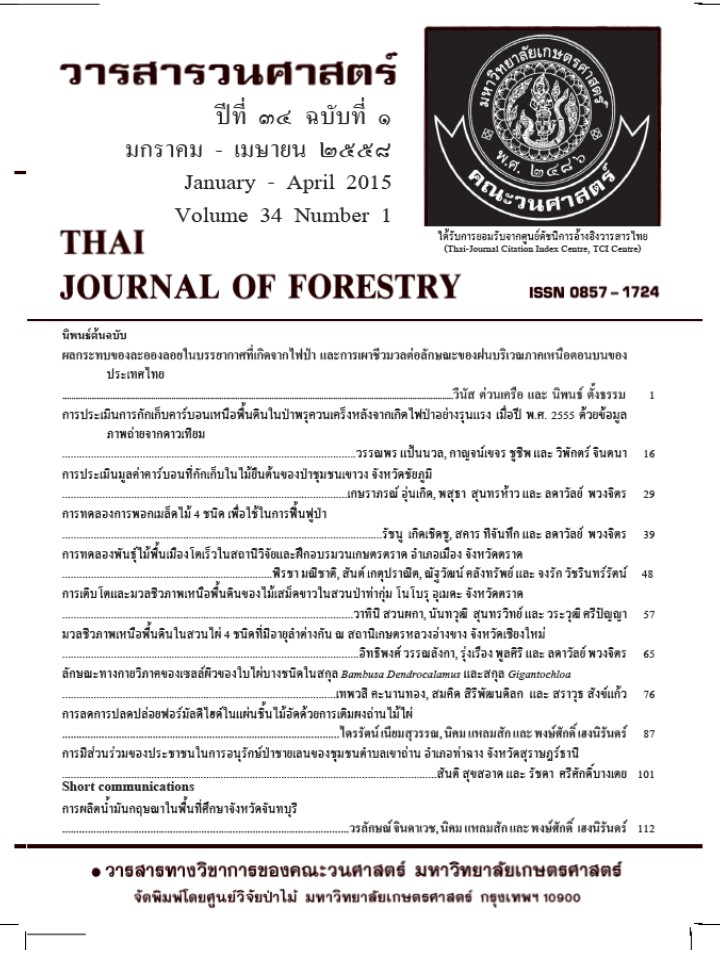ผลกระทบของละอองลอยในบรรยากาศที่เกิดจากไฟป่า และการเผาชีวมวลต่อลักษณะของฝนบริเวณภาคเหนือตอนบนของประเทศไทย
Main Article Content
บทคัดย่อ
การเผาไหม้มวลชีวภาพทางภาคเหนือตอนบนของประเทศไทยมีแนวโน้มที่จะเป็นสาเหตุหลักของละอองลอยในบรรยากาศ (aerosols) มากขึ้นซึ่งอาจมีผลกระทบต่อปริมาณน้ำฝนโดยเฉพาะในช่วงฤดูกาลเผา งานการวิจัยนี้มีวัตถุประสงค์เพื่อศึกษาผลกระทบของละอองลอยในบรรยากาศที่ต่อเมฆ และปริมาณน้ำฝนในบริเวณภาคเหนือตอนบนของประเทศไทยโดยใช้การวิเคราะห์การถดถอยพหุคูณ ข้อมูลจากภาพถ่ายดาวเทียม MODIS (Terra/Aqua) และข้อมูลจากสถานี AERONET ตั้งแต่ปี ค.ศ. 2003-2012 ผลการศึกษาพบว่า ค่าการสลัวลงของแสงจากละอองลอยในบรรยากาศ (AOT) มีค่าสูงสุดในฤดูก่อนมรสุมโดยเฉพาะอย่างยิ่งเดือนมีนาคมบริเวณจังหวัดเชียงราย พะเยาและแพร่ (เฉลี่ยประมาณ 0.5) ซึ่งสอดคล้องกับข้อมูลจุดความร้อนจากการเผาชีวมวล (hotspot) และลดลงในเดือนมิถุนายนถึงกรกฎาคม นอกจากนี้ยังพบว่าในช่วงฤดูฝนจะพบอนุภาคละอองลอยขนาดใหญ่เป็นส่วนใหญ่แต่ในช่วงฤดูก่อนมรสุมกับพบละอองลอยอนุภาคขนาดเล็กเกือบทั้งหมดซึ่งมาจากเขม่าควันไฟที่เกิดจากการเผาชีวมวลในช่วงนั้น ทั้งนี้ยังพบว่าปริมาณน้ำฝน (R) มีความสัมพันธ์มากกับปริมาณเมฆปกคลุมท้องฟ้า (CF) และปริมาณน้ำที่เป็นของเหลวในเมฆ (CWC) ในทิศทางเดียวกัน และมีความสัมพันธ์อย่างมากกับค่าการสลัวลงของแสงจากละอองลอยในอากาศ (AOT) และจุดความร้อน (HP) ในทิศทางตรงกันข้ามของทุกจังหวัด การวิเคราะห์การถดถอยพหุคูณแสดงให้เห็นว่าละอองลอยในบรรยากาศมีความสัมพันธ์แบบผกผันกับปริมาณน้ำฝนอย่างมีนัยสำคัญ นอกจากนี้พบข้อสังเกตว่าในปีใดที่มีการเผาชีวมวลสูงซึ่งทำให้เกิดละอองลอยในบรรยากาศมากอาจส่งผลทำให้ฝนเริ่มตกช้ากว่าปกติประมาณ 1-2 เดือน
Downloads
Article Details

อนุญาตภายใต้เงื่อนไข Creative Commons Attribution-NonCommercial-NoDerivatives 4.0 International License.
ข้าพเจ้าและผู้เขียนร่วม (ถ้ามี) ขอรับรองว่า ต้นฉบับที่เสนอมานี้ยังไม่เคยได้รับการตีพิมพ์และไม่ได้อยู่ในระหว่างกระบวนการพิจารณาตีพิมพ์ลงในวารสารหรือสิ่งตีพิมพ์อื่นใด ข้าพเจ้าและผู้เขียนร่วม (ถ้ามี) ยอมรับหลักเกณฑ์และเงื่อนไขการพิจารณาต้นฉบับ ทั้งยินยอมให้กองบรรณาธิการมีสิทธิ์พิจารณาและตรวจแก้ต้นฉบับได้ตามที่เห็นสมควร พร้อมนี้ขอมอบลิขสิทธิ์ผลงานที่ได้รับการตีพิมพ์ให้แก่วารสารวนศาสตร์ คณะวนศาสตร์ มหาวิทยาลัยเกษตรศาสตร์ กรณีมีการฟ้องร้องเรื่องการละเมิดลิขสิทธิ์เกี่ยวกับภาพ กราฟ ข้อความส่วนใดส่วนหนึ่ง หรือ ข้อคิดเห็นที่ปรากฏในผลงาน ให้เป็นความรับผิดชอบของข้าพเจ้าและผู้เขียนร่วม (ถ้ามี) แต่เพียงฝ่ายเดียว และหากข้าพเจ้าและผู้เขียนร่วม (ถ้ามี) ประสงค์ถอนบทความในระหว่างกระบวนการพิจารณาของทางวารสาร ข้าพเจ้าและผู้เขียนร่วม (ถ้ามี) ยินดีรับผิดชอบค่าใช้จ่ายทั้งหมดที่เกิดขึ้นในกระบวนการพิจารณาบทความนั้น”


